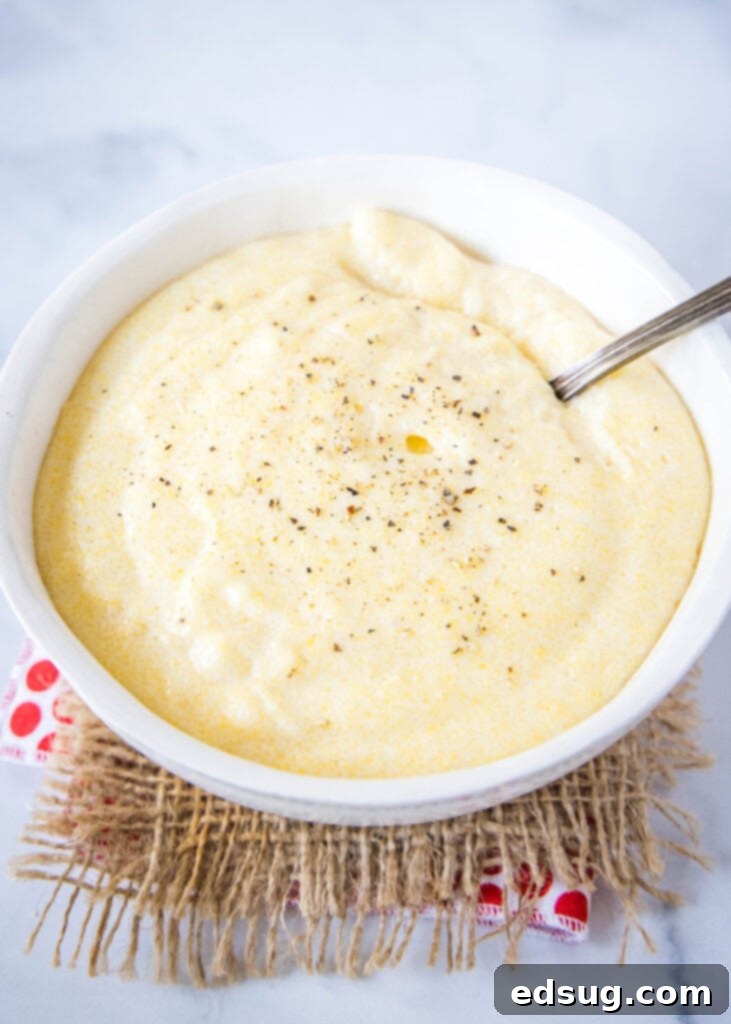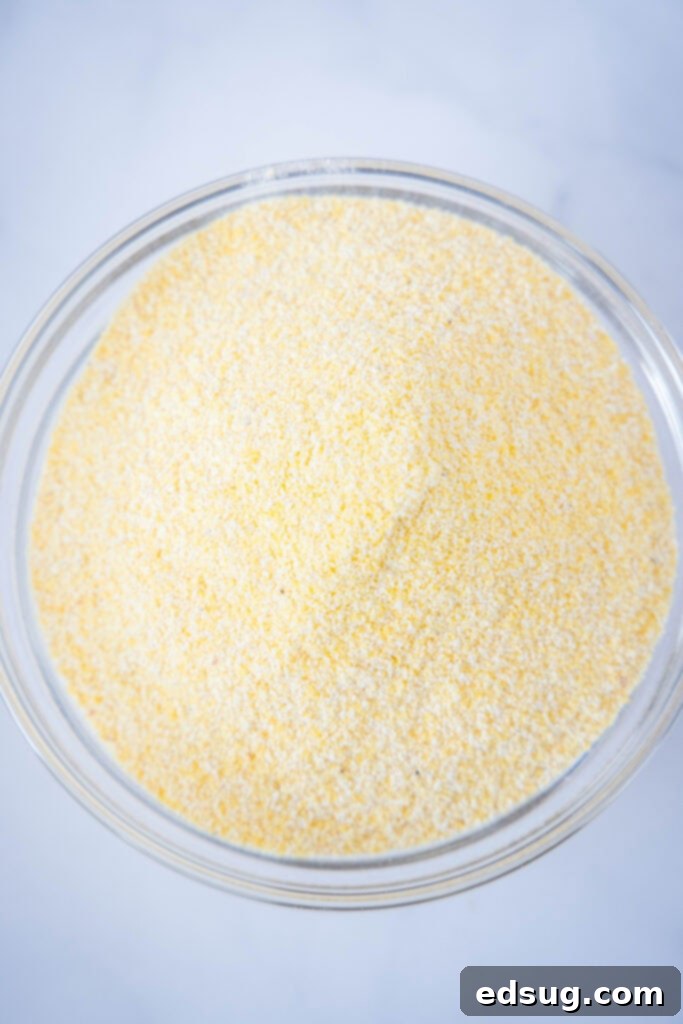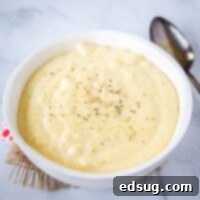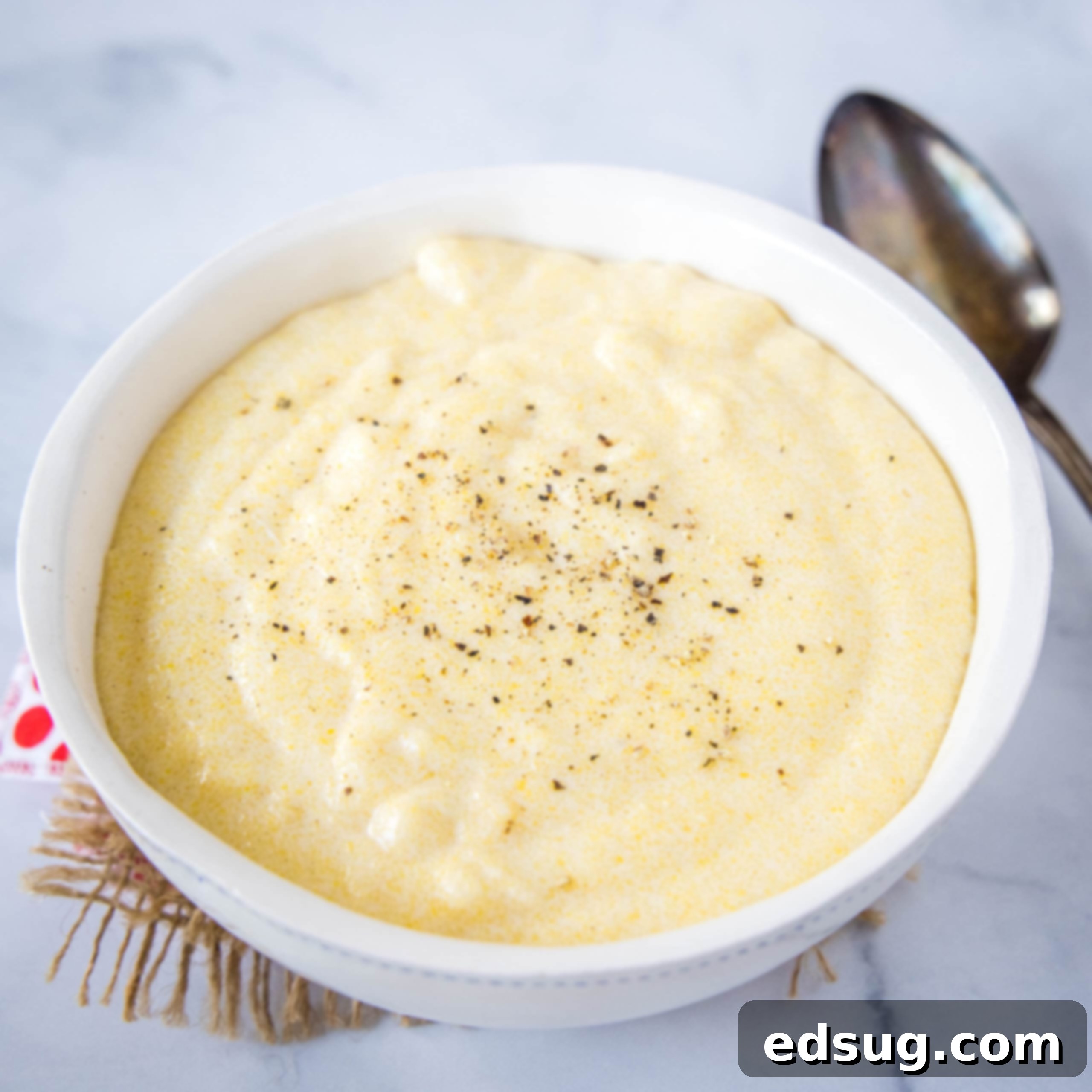The Ultimate Guide to Making Creamy Polenta: A Versatile & Delicious Side Dish
For many home cooks, finding a side dish that pleases everyone at the table can feel like a nightly challenge. Vegetables are often met with skepticism, unless they are loaded with butter, like Corn On The Cob, or drenched in dressing, such as a Side Salad. This ongoing quest for a crowd-pleasing accompaniment is why a recipe like this Creamy Polenta becomes an absolute game-changer in our household. It’s incredibly quick to prepare, boasts a wonderfully smooth and rich texture, and offers endless possibilities for customization with different cheeses and seasonings, making it the perfect partner for almost any main course.
This simple yet sophisticated dish has earned its spot in our regular rotation. Its inherent creaminess, coupled with how easily its flavor profile can be adapted, means it complements everything from hearty meat dishes to lighter vegetarian meals. If you’re looking to elevate your dinner experience without adding extra stress to your cooking routine, learning how to master creamy polenta is an excellent place to start. Let’s delve into what makes this humble cornmeal dish so extraordinary and how you can achieve restaurant-quality results in your own kitchen.

What Exactly Is Polenta? Unraveling the Italian Staple
At its core, polenta is a dish made from coarsely ground yellow cornmeal. While technically derived from corn, making it a vegetable, its starchy nature often leads it to be categorized alongside grains or starches. This duality highlights its remarkable versatility, allowing it to serve as a comforting side dish or even a robust base for a main course. Its mild, naturally sweet flavor acts as a true “blank canvas,” eagerly absorbing the flavors of whatever ingredients it’s cooked with or served alongside. This makes it an ideal foundation for culinary creativity, enabling you to tailor it to countless different cuisines and personal preferences.
Traditional creamy polenta recipes, like the one we’re exploring today, begin with dry, grainy cornmeal. This raw form, when cooked slowly with liquid and constant stirring, transforms into a luscious, soft porridge. However, you might also encounter polenta pre-packaged in a tube, resembling a log of sausage. This ready-to-use version is typically pre-cooked and cooled, designed for slicing and pan-frying or grilling. The result is a delightful texture contrast – crispy on the outside, yet still tender on the inside. While equally delicious, this pre-made variety isn’t suitable for achieving the silky, pourable creamy polenta that is the focus of this recipe.
Polenta’s roots trace back to Northern Italy, where it originated as a staple for farmers and peasants. It was prized for its affordability, ease of preparation, and its ability to provide a filling, energy-rich meal that sustained hardworking individuals for hours. Historically, it was a cornerstone of the regional diet, often cooked over an open fire in a large copper pot. Over centuries, polenta has transcended its humble beginnings to become a celebrated ingredient in global cuisines, cherished for its adaptability and comforting qualities. It’s also naturally gluten-free, making it a wonderful option for those with dietary restrictions.

Are Polenta, Cornmeal, and Grits the Same Thing? A Clarification
While polenta, cornmeal, and grits are all derived from dried corn and share similar textures, they are distinct ingredients with specific characteristics and culinary applications. Understanding these differences is key to achieving the best results in your cooking.
Polenta, as we’ve established, is made from yellow corn and typically features a medium to coarse grind. This particular grind size is what gives creamy polenta its characteristic “toothy” bite and pleasing texture – it’s not perfectly smooth, but rather has a delightful body and mouthfeel. The golden hue of our creamy dish is a direct result of the yellow corn used.
Cornmeal, on the other hand, can be produced from both yellow and white corn, but it is generally milled to a much finer consistency than polenta. This finer grind makes it ideal for baking applications, such as classic cornbread, muffins, or even as a dusting agent for pizza peels and baking sheets to prevent dough from sticking and to impart a desirable crispy crust.
Finally, grits are also a coarsely ground corn product, but they are exclusively made from white corn, specifically hominy – corn kernels that have been treated with an alkali process (nixtamalization) to remove the hull and germ. This process gives grits a slightly different flavor profile and texture. While grits can often be substituted in many polenta recipes, they will naturally result in a lighter, almost white appearance compared to the golden glow of yellow polenta.

Key Ingredients for the Perfect Creamy Polenta
Creating truly outstanding creamy polenta starts with a few simple, high-quality ingredients. Each component plays a crucial role in achieving that signature smooth texture and rich flavor:
- Milk: For the most luxurious and velvety polenta, I wholeheartedly recommend using full-fat milk. The higher fat content contributes significantly to both the creaminess and the richness of the final dish. While 2% or skim milk can be used in a pinch, they will yield a slightly less decadent result. For a dairy-free alternative, full-fat coconut milk or a rich oat milk can be surprisingly delicious, though the flavor profile will shift.
- Chicken Broth: This is one of my top kitchen hacks for adding depth of flavor to starchy dishes like rice, quinoa, and especially polenta. Using broth instead of plain water infuses the polenta with savory notes that elevate it far beyond what water alone can achieve. Vegetable broth is an excellent alternative for a vegetarian-friendly version. I always opt for low-sodium broths to maintain control over the overall saltiness of the dish, allowing me to season it precisely to my taste.
- Uncooked Polenta: Ensure you are using dry, uncooked polenta. This is the grainy cornmeal, not the pre-cooked, tubular variety found in some specialty stores. For the creamiest texture, a fine or medium grind polenta works best as it cooks down more smoothly. Coarser grinds will result in a more textured, rustic polenta.
- Salt: A good quality fine sea salt is preferred for its clean flavor. Proper seasoning is vital, not just at the end, but also by ensuring your cooking liquids are subtly seasoned from the start. This builds flavor from the inside out.
- Reduced-Fat Cream Cheese: While polenta naturally thickens and becomes creamy due to its starch content and continuous stirring, the addition of cream cheese takes it to an entirely new level of decadence. Reduced-fat cream cheese is perfect here because it adds a lovely tang and an incredible, silky smoothness without making the polenta overly heavy or greasy, which can sometimes happen with full-fat versions. It helps create a stable emulsion, ensuring a consistently creamy texture.
Elevate Your Polenta: Delicious Customization Ideas
While this creamy polenta recipe is absolutely perfect as written, its “blank canvas” nature makes it wonderfully adaptable to your tastes and the meal you’re serving. Don’t hesitate to experiment with different additions to create unique and flavorful variations:
Cheesy Indulgences: Incorporating cheese is one of the most popular ways to enhance polenta. Beyond the cream cheese, consider stirring in a few generous grates of nutty, aged cheeses like Parmesan or Pecorino Romano for a sharp, savory kick. A good quality cheddar cheese also melts beautifully and adds a familiar, comforting flavor. For something richer, try Fontina, Gruyere, or even a tangy goat cheese for a gourmet touch. The key is to add cheese towards the end of cooking or just after removing it from the heat, ensuring it melts smoothly into the hot polenta.
Herbaceous Accents: Fresh herbs can brighten and deepen the flavor profile. Finely chopped fresh thyme, rosemary, or sage are classic Italian pairings. For a fresh finish, stir in some chopped fresh parsley or chives just before serving. Dried herbs can also be added during the cooking process to infuse the polenta more deeply.
Spicy & Savory Kicks: If you’re looking for a bolder flavor, feel free to omit some of the initial salt and instead season your polenta with an equal amount of your favorite spice blends. Seafood seasoning, seasoned salt, or a robust Cajun seasoning can transform the polenta into an ideal accompaniment for grilled fish or spicy meats. For an authentic Italian touch, a good quality Italian seasoning blend is always a winner. A generous amount of freshly cracked black pepper also adds a wonderful aromatic warmth and subtle spice.
Other Delicious Mix-ins: Don’t limit yourself to just cheese and seasonings! Consider folding in other ingredients for added texture and flavor:
- Roasted Garlic: Adds a sweet, mellow garlic flavor.
- Sun-dried Tomatoes: Provides a concentrated, tangy sweetness.
- Sautéed Mushrooms: Earthy and umami-rich, perfect for a heartier polenta.
- Caramelized Onions: A touch of sweet and savory depth.
- Pesto: Swirl in a dollop of fresh basil pesto for vibrant flavor and color.
These variations allow you to customize your creamy polenta to perfectly match the main course or simply to enjoy it as a standalone comforting dish.

Step-by-Step Guide to Making Silky Smooth Creamy Polenta
Achieving truly creamy polenta is less about complex techniques and more about patience and consistent stirring. Follow these steps for a perfect batch every time:
- Prepare the Liquids: Begin by combining your milk and chicken broth in a heavy-bottomed saucepan. Heat the liquids over medium heat until they reach a gentle simmer. It’s crucial to be mindful when heating milk, as it has a tendency to boil over very quickly and create a significant mess. Avoid cranking the heat to high and walking away. Keep the heat on medium and watch it carefully, stirring occasionally to prevent the milk from scorching on the bottom of the pot. A gentle simmer, where you see small bubbles forming around the edges, is exactly what you’re looking for.
- Gradually Add Polenta: Once the liquids are simmering, begin to gradually sprinkle in the uncooked polenta with one hand while continuously whisking with the other. This slow addition and constant stirring are vital to prevent the polenta from clumping and ensure a smooth, uniform texture. Think of it as creating a smooth slurry that gradually thickens. Reduce the heat to low after all the polenta has been added.
- Cook and Stir for Creaminess: This is where the magic happens! The coarse grains of polenta will need approximately 15-20 minutes to fully absorb the liquids and soften into a creamy consistency. Throughout this cooking time, it is essential to stir frequently – ideally every minute or two, or even more often towards the end. Not only does this prevent the polenta from sticking and burning at the bottom of the pot, but constant stirring also helps the starches within the cornmeal to release and create that ultimate creamy, luscious texture. You’ll notice the mixture bubbling gently and becoming progressively thicker. Keep stirring until it pulls away from the sides of the pot easily and reaches your desired consistency – it should be thick but still pourable.
- Finish with Flavor and Cream: Once the polenta has reached its ideal creamy state, remove the pot from the heat. Stir in the salt and the reduced-fat cream cheese until both are fully incorporated. The residual heat from the polenta will quickly melt the cream cheese, blending it seamlessly into the mixture. While a completely uniform texture is the goal for ultimate creaminess, some people enjoy the visual appeal and occasional pockets of flavor from slightly less incorporated cream cheese ribbons – this is purely a matter of personal preference!
- Serve Immediately: Creamy polenta is best enjoyed fresh off the stove while it’s still warm and smooth.

What Do You Eat with Creamy Polenta? Perfect Pairings for Any Meal
As I’ve mentioned, the beauty of creamy polenta lies in its incredible versatility; it truly pairs well with just about anything! Its mild flavor and rich texture make it a fantastic absorbent base for robust sauces and gravies, while also complementing lighter proteins and vegetables. While we frequently enjoy it with savory pork chops, here are even more excellent pairing ideas to inspire your next meal:
- Smoked Chicken Thighs: The smoky depth of chicken thighs is beautifully balanced by the creamy, mellow polenta.
- Instant Pot BBQ Chicken: The tangy, sweet, and savory notes of BBQ chicken find a perfect partner in the creamy texture of polenta, which can soak up all that delicious sauce.
- Air Fryer Pork Chops: Crispy on the outside, juicy on the inside, these pork chops provide a textural contrast and rich flavor that melds wonderfully with smooth polenta.
- Sous Vide Pork Loin: The tender, perfectly cooked pork loin benefits from the comforting and creamy accompaniment of polenta, especially when served with a complementary pan sauce.
- Slow Cooker Balsamic Pork: The rich, sweet, and tangy flavors of balsamic-glazed pork stew or roast are heavenly spooned over a bed of creamy polenta.
- Braised Short Ribs or Osso Buco: For a truly decadent meal, serve polenta with slow-cooked, fall-off-the-bone meats and their rich, flavorful gravies.
- Meatballs in Tomato Sauce: A classic Italian pairing, the polenta acts like a delicious, gluten-free pasta, absorbing all the wonderful tomato and meat flavors.
- Sautéed Mushrooms or Ratatouille: For vegetarian options, a medley of savory sautéed mushrooms or a vibrant ratatouille makes a delightful topping for creamy polenta.
- Poached Eggs with Truffle Oil: A sophisticated brunch or light dinner option, the runny yolk and earthy truffle oil are luxurious with polenta.
- Garlic Butter Shrimp: The light, garlicky shrimp offers a fantastic contrast to the rich polenta.
Preparing Ahead and Storing Your Creamy Polenta
While this recipe is wonderfully quick to make fresh, it’s also a fantastic make-ahead option, which is ideal for busy weeknights or when preparing for a larger dinner party. Cooked creamy polenta can be stored in an airtight container in the refrigerator for up to 3 days. It will firm up considerably as it cools, transforming from a soft porridge into a more solid block – this is perfectly normal!
To reheat leftovers or to revive your make-ahead polenta for serving, simply transfer it back to a pot on the stove. Add approximately 1/4 cup of additional chicken broth, vegetable broth, or even water per serving. Heat over medium-low heat, stirring frequently. As it warms, the polenta will gradually relax and absorb the added liquid, returning to its creamy, luscious glory. You may need to add a little more liquid until it reaches your desired consistency.
It’s important to note that when recipes are chilled, flavors, particularly salt, can become muted. Therefore, always taste test your reheated polenta and correct the seasoning with an extra pinch of salt or fresh black pepper before serving. This ensures that every bite is as flavorful as it was when freshly made.
For longer storage, polenta can also be frozen. Once cooled and firm, you can slice it into portions, wrap them tightly in plastic wrap, and then place them in a freezer-safe bag or container. It will keep in the freezer for up to 2-3 months. To reheat from frozen, you can gently warm it in a saucepan with liquid, or even bake slices in the oven, though the baked version will have a firmer texture. Allow it to thaw in the refrigerator overnight before reheating on the stove for the best creamy results.
No matter what delicious main course you choose to serve this creamy polenta recipe with, its comforting texture and adaptable flavor profile are sure to make it a cherished favorite that you’ll find yourself coming back to again and again.

More Quick & Delicious Side Dishes to Try
If you’ve loved how straightforward and satisfying this creamy polenta recipe was to make, then you’ll certainly appreciate some of my other favorite quick and easy side dishes. They offer similar convenience and flavor, perfect for rounding out any meal:
- Lemon Herb Potato Salad
- Corn Fritters
- Smoked Mac and Cheese
- Corn Muffins
- Broccoli Rice Casserole
We truly hope you enjoy this Creamy Polenta as much as my family and I do. If it becomes a hit in your kitchen, please consider sharing it with your friends and family so they can discover this delightful and versatile side dish too!

Creamy Polenta
Pin Recipe
Rate Recipe
Print Recipe
Ingredients
- 2 cups milk
- 1 cup chicken broth
- 3/4 cup uncooked polenta
- 1 teaspoon salt
- 2 ounces cream cheese
Instructions
-
In a saucepan over medium heat bring the milk and chicken broth to a simmer. Be careful not to heat too fast or the milk with scald on the bottom of the pan and it will boil over quickly.
-
Once it is starting to simmer, gradually add the polenta while stirring to prevent it from clumping. Reduce the heat to low.
-
Let this cook for about 15-20 minutes for it to absorb all the liquid and soften. You will want to stir frequently, as it gets thick it will start to bubble.
-
Remove from the pot from heat and stir in the salt and cream cheese until it is fully incorporated.
-
Serve immediately
Nutrition
Nutrition information is automatically calculated, so should only be used as an approximation.
Additional Info
Like this recipe? Leave a comment below!
I created a fun group on Facebook, and I would love for you to join us! It’s a place where you can share YOUR favorite recipes, ask questions, and see what’s new at Dinners, Dishes and Desserts (so that you never miss a new recipe)!
Be sure to follow me on Instagram and tag #dinnersdishes so I can see all the wonderful DINNERS, DISHES, AND DESSERTS recipes YOU make!
Be sure to follow me on my social media, so you never miss a post!
Facebook | Twitter | Pinterest | Instagram
.
